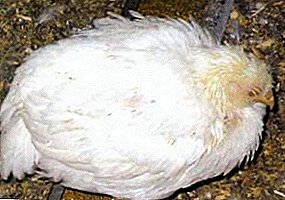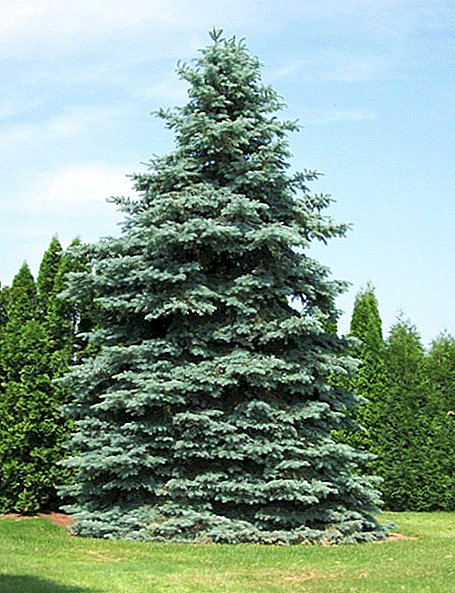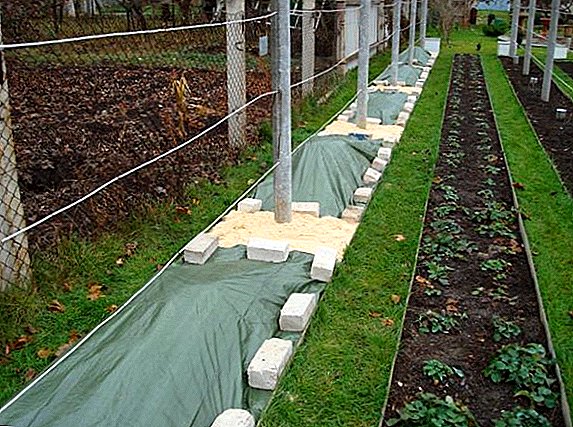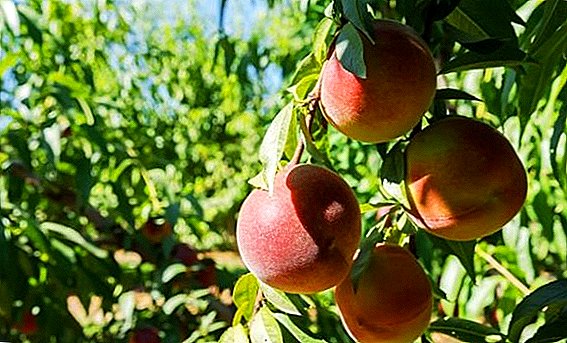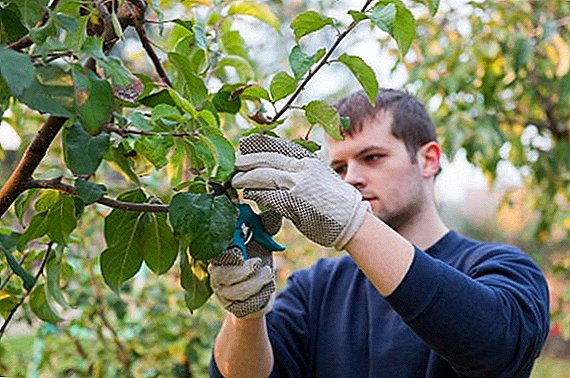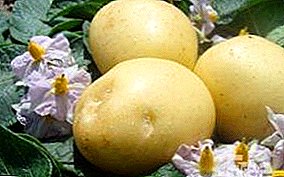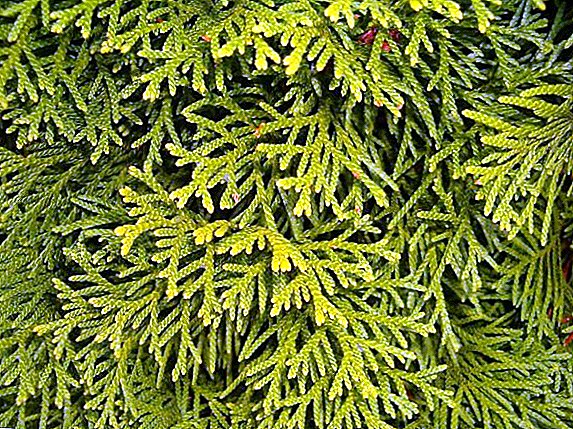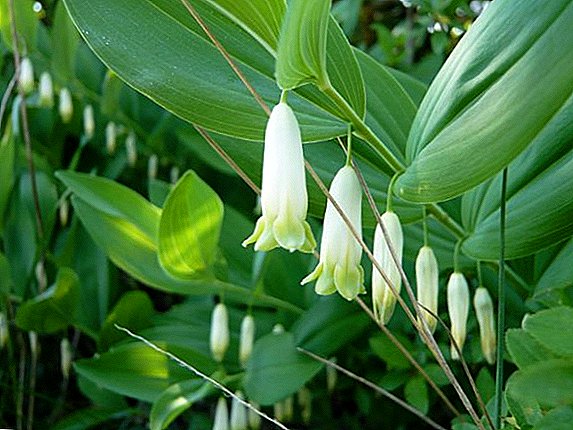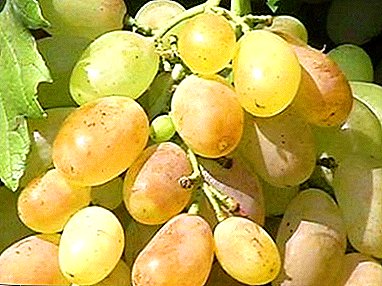
The grape variety "Valentine" every year pleases gardeners with a rich harvest of sweet and fragrant berries. Its luxurious amber clusters sometimes reach gigantic proportions.
Considered to be one of the best market varieties, it is successfully grown not only in professional vineyards, but also in home gardens.
"Valentine" does not impose special requirements for care and deserves to become the favorite variety of winegrowers.
Valentine variety description
Grapes "Valentine" refers to table forms of grapes with an average ripening period. The same terms are possessed by the Gift of Zaporozhye, Valentine and the First Called.
The variety has a harmonious taste, beautiful appearance, endurance for some diseases and a lot of other advantages. The grapes are very tasty fresh, and also, like Friendship, Krasin or Tempranillo is well suited for making wine and juices.
Inexperienced gardeners sometimes confuse "Valentina" with the variety "Valentin" ("Androkos"). This is a completely different variety, the berries of which are colored blue.
Appearance of grapes
 Grapes "Valentine" is famous for strong-growing shrubs and vines growing widely. The form of bunches of grapes is slightly loose, cylindrical, elongated in the lower part.
Grapes "Valentine" is famous for strong-growing shrubs and vines growing widely. The form of bunches of grapes is slightly loose, cylindrical, elongated in the lower part.
The grade differs in the huge sizes of clusters. Some specimens can reach 40 cm in length and 1.5 kg in weight. Large clusters are also characteristic of the Original, Delight and Merlot varieties.
"Valentina" berries are beautiful and very large, weighing up to 16 g, up to 26 mm wide and up to 44 mm long. The shape of the fruit is elongated and slightly curved.
The color of the berries is golden yellow or amber yellow in the sun. On the skin there is a nice "caulk", which is considered a varietal feature of "Valentina". On the barrels of berries with an intense sun there is a light brown tan. Varieties of berries ripen at the same time. Clusters are practically not subject to pea.
The pulp of the fruit is very delicate and seems to melt in the mouth. The skin is thin, easily eaten. Stone in the fruit - from 1 to 2 pieces. The taste of the berries is harmonious with a slight taste of sage. A well-ripened berry has a delicate nutmeg aroma. The acidity of the fruit - from 5 to 6 g / l, sugar content - from 16 to 19%. With a professional tasting, the variety was awarded a score of 8.6 points.
Galahad, Kuban and Strasensky also have a high tasting score.
Breeding history and breeding region
Grapes "Valentine" - is the result of the work of breeders VNIIVIV them. ME AND. Potapenko Novocherkassk city.
The variety is bred by complex crossing of the Muscat summer variety and a hybrid obtained from Arcadia and Delight. "Valentine" refers to covering or semi-covering grape varieties. It is grown in many regions of Russia, stretching from the Moscow region to Astrakhan, but with mandatory shelter for the winter.
Specifications
The variety produces high and stable yields every year.He begins to bear fruit in the second year of life. Berries ripen in about 140 days from the start of bud break or a little earlier. The first fruiting is not so abundant, but next year you can expect an increase in yield of 1.5, or even 2 times. The fruitfulness of grapes is good - from 60 to 75%. Mature three-quarter shoots. When pruning on the vine leave from 8 to 12 buds.
 The flowers of "Valentina" are bisexual, so that this wonderful grape does not need pollinator varieties.
The flowers of "Valentina" are bisexual, so that this wonderful grape does not need pollinator varieties.
Amethyst Novocherkassky, Angelica and Aladdin also possess a flower hollow.
The variety is able to withstand the air temperature not lower than -22 ° С. With more severe frosts, part of the kidneys may freeze, which threatens to significantly reduce the future harvest. Therefore, it is recommended to warm the grapes for winter.
To do this, in the fall cut and sick sore branches, and then abundantly watered and mulch the bush. Before the onset of frost, the bush is wrapped in a covering material, bent down and covered with earth.
Such varieties as Isabella, Crystal and Marcelo require shelter.
The variety does not like excessive moisture.
Watering it is required only in the spring and at that time when the berries are just starting to pour juice. The skin of the fruits of "Valentina" is very thin, so when watering or during heavy rains, it tends to burst. As a result, the quality, transportability and shelf life of the crop are reduced.
Since the bushes of grapes "Valentine" have strong growth, they need a large space for normal development. The optimal scheme of planting bushes - 4 to 6 meters. The depth of groundwater in the area must be at least 3 meters from the surface of the earth, as the roots of the grapes go deep into.
Planted variety "Valentine" is recommended in the spring. Caring for grapes is the same as for other varieties: watering, pruning, fertilizing and tying. From fertilizers, grapes prefer mineral (superphosphate, potash salt) and organic (wood ash, manure).
A photo




Diseases and pests
Valentines grapes are not afraid of gray rot, have medium resistance to oidium and good resistance to mildew. With the defeat of the bush with oidium, a gray-white bloom appears on the leaves, which eventually passes into inflorescences and clusters. With a strong defeat shoots become covered with mold and from the bush smells like rotten fish. Oidium can destroy most of the crop.
 You can fight the disease with the help of simple agrotechnical methods and by spraying the plant with special preparations. When caring for grapes, it is important not to allow strong thickening of the bushes and to provide them with good ventilation.
You can fight the disease with the help of simple agrotechnical methods and by spraying the plant with special preparations. When caring for grapes, it is important not to allow strong thickening of the bushes and to provide them with good ventilation.
To do this, you need to regularly thin out the shoots, remove the stepchildren and tie up the vine. The soil around the plant should be regularly loosened and free from weeds.
For the prevention and treatment of oidium used drugs such as colloidal sulfur, "Strobe", "Thanos", "Skor", "Bayleton", "Topaz", "Horus". Processing plants spend three times per season: in the spring when the regrowth of young shoots 15 cm, before flowering and at the time of fruit set in the pea stage. To reduce the number of causative agents of oidium, it is also recommended autumn processing of grapes - after harvest.
Plants affected by oidium, leaves and clusters of plants must be removed and burned in order to stop the further spread of the disease.
Preventive measures against common grape diseases - anthracnose, chlorosis, bacteriosis and rubella will not harm plants.
Any grape variety can be attacked by pests, and Valentine is no exception.
Phylloxera, grape pruritus, spider mite, leafworm - this is not the entire list of harmful insects that are dangerous to the plant. The following measures are effective for protection against pests:
- weeding, cleaning of fallen leaves, removal of damaged parts of the plant;
- thinning bushes for good ventilation;
- cleaning and destruction of old exfoliated bark, in which pests can spend the winter;
- trapping caterpillars and pests;
- the use of beneficial insects that feed on pests.
With the defeat of the bushes used drugs contact or systemic action:
- Phylloxera. In the form of phylloxera, Confidor, Actellic, Zolon is used. With the defeat of the roots helps partial flooding of the root system of the vineyard with water for up to 8 weeks. The most radical way is to completely uproot all the bushes in the lesion focus. The most effective way to protect against the pest is growing grapes on a phylloxero-resistant rootstock.
- Spider mite Prevention of mite is the timely removal of weeds under the bushes of grapes, where insects develop. To destroy the pest is sprayed plants "Fufanon" or "Iskra-M". The first treatment is carried out in May. In the summer, spraying with sulfur-containing preparations is recommended, which act most effectively at a temperature of 22 ° C and above.
- Grape pruritus To protect against itching, the acaricides "Neoron", "Sunmite", "Omite", "Talstar", "Aktellik" and sulfur preparations are used. Processing is carried out in the spring and in the fall.
- Listovertka. Preparations Spark-D, Konfidor, Fury, Kinmiks, Sherpa, Komandor help fight this pest. Spraying of plants is carried out in the spring and summer. Clearing the bushes in the fall and spring from the old bark with subsequent burning is very effective in combating the leafworm - up to 70% of the wintering pupae of the pest are destroyed.
On a land rich in sand, phylloxera does not survive.
 Sweet grapes "Valentine" with a thin delicate skin are like to feast on wasps. Easily biting through ripe berries and feeding on their juicy pulp, they are able to destroy most of the crop.
Sweet grapes "Valentine" with a thin delicate skin are like to feast on wasps. Easily biting through ripe berries and feeding on their juicy pulp, they are able to destroy most of the crop.
The most effective measures to combat wasps are traps with juice, syrup or beer, placed along the site, special grids on clusters and the destruction of wasp nests.
Birds also like to eat ripe grapes. Birds pests prefer to eat only fresh juice, so every time they peck at new berries, the damaged fruits immediately attack the wasps. Protect the crop from birds by using rattles, mirror objects and sound scarers. But these measures give a temporary effect, as the birds quickly get used to them. As experience shows, grapes are protected best of all by a special net from birds, which covers the vineyard.
When choosing grapes for your plot, pay attention to the variety of Valentine. With good care, this variety is capable of bringing a rich harvest of delicious amber berries every year.


